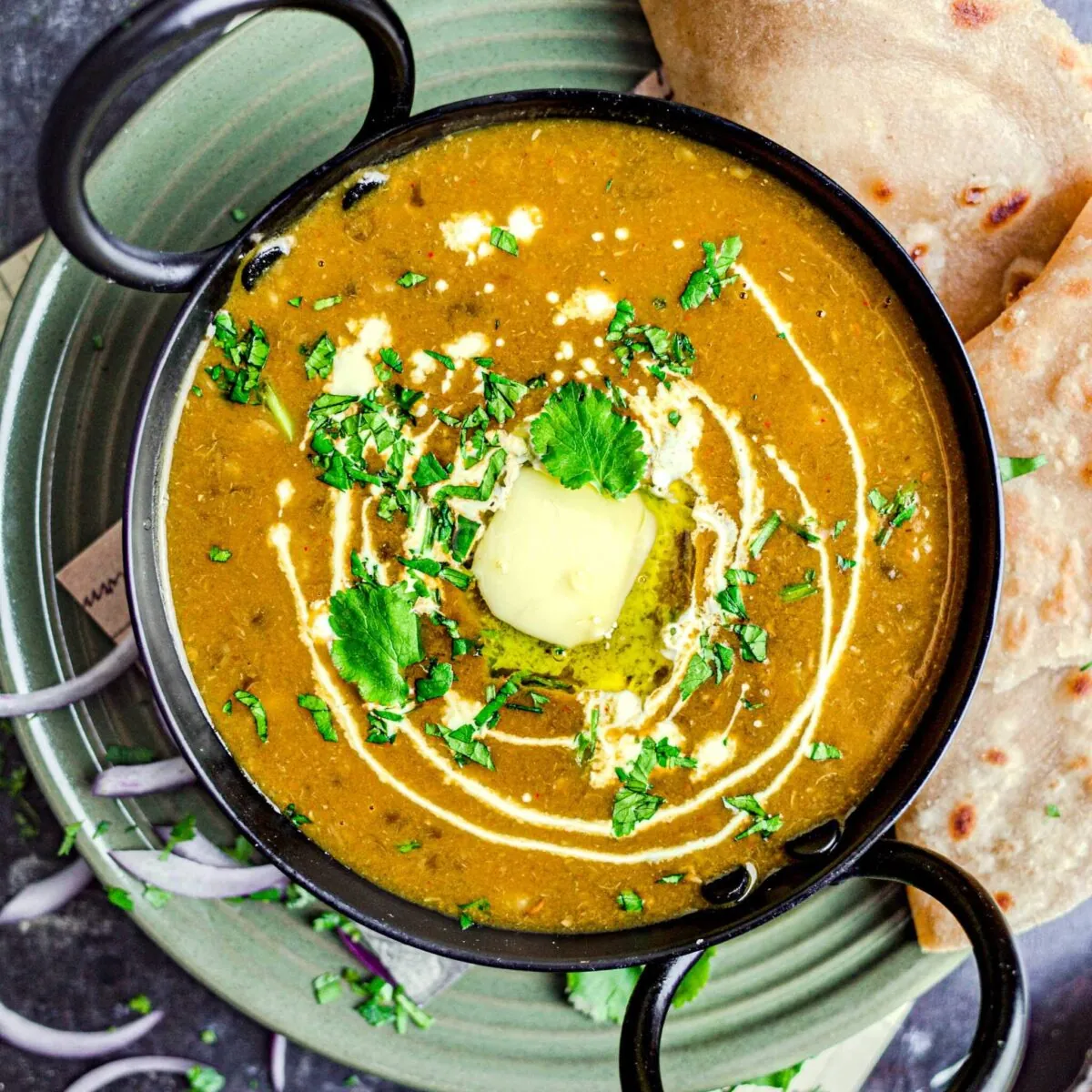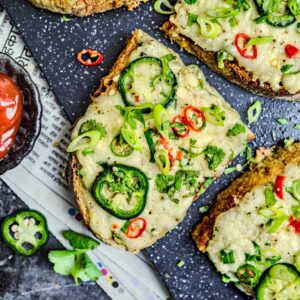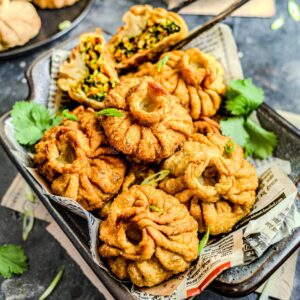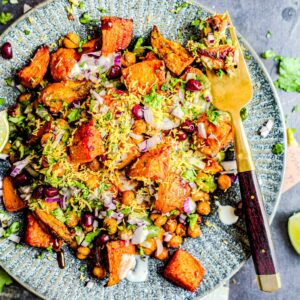Dal Bukhara Recipe (Hotel Style)
Lovingly simmered with garlic, cream, and plenty of butter, these black lentils are unbelievably rich and velvety. The sweet aroma, full-bodied flavour, and smoky depth are bonuses that make it impossible to stop eating. This dal bukhara recipe lives up to the original’s reputation in every way possible, so there’s no need to travel to Delhi!

Of all the Indian lentil dishes — and there’s a lot! — Dal bukhara is one of the most sumptuous. While dal bhaji or Maharashtrian drumstick dal is rustic, homely, and comforting, in contrast, dal bukhara is impressive, rich, and just begging to be paired with eggless garlic naan.
Don’t get me wrong: Each spoonful tastes of warmth and cosiness. But it’s punctured with an undeniable note of indulgence and temptation.
Until recently, nobody in my household was a fan of black lentils. Not even convinced by Dishoom’s famous black dal makhani, they preferred a classic bowl of dal tadka. That is until I started recipe testing for dal bukhara.
Dal bukhara boasts everything people love about dal makhani — the creaminess, delicate spicing, and earthy smokiness — with less work and a more defined, complex flavour.
It’s the perfect vegetarian meal. Lavish enough for festive platters, but robust and wholesome for everyday meals, too. Honestly, there’s no situation where dal bukhara isn’t a good idea.
🤯 Why This Dal Bukhara Recipe is a Keeper
❓What is Dal Bukhara
Dal bukhara is an Indian lentil dish hailing from Punjab — Northwest India. It’s made from black lentils, aromatic spices, spices, plus pleeeeenty of butter and cream.
Dal bukhara has a rather intriguing history. It’s a relatively modern dish (compared to other lentil-based foods like vegetable sambar, for example!) yet has already achieved legendary status.
Why don’t we explore more below?

Dal Bukhara and Dal Makhani Difference
At first glance, dal bukhara and dal makhani look almost identical. They’re both slow-cooked black lentil dishes — So, what’s the difference? Let’s go over it!
Subtle changes in ingredients can make a noticeable difference. Perhaps most prominently, dal makhani includes both whole urad dal (black lentils) and rajma (kidney beans) in its preparation, whereas dal bukhara only uses whole black lentils.
Furthermore, dal bukhara has a more intense tomato flavour thanks to fresh tomatoes and tomato puree. This lends the dal a certain sweetness and distinctive umami (tomatoes are high in natural umami).
Dal makhani uses plenty of chopped onion. Comparatively, dal bukhara doesn’t include any.
While both dishes are known to be rich, dal bukhara wins the award here. It’s much higher in butter and cream than dal makhani, resulting in an ultra-luxurious eating experience.
So, dal bukhara vs dal makhani: Which is tastier? It’s completely up to your preference! Dal makhani may be more famous, but I recommend that everyone who loves creamy dal dishes try dal bukhara — you may be surprised!
Who Invented Dal Bukhara?
We can thank Madan Jaiswal, the original head of the legendary restaurant Bukhara (yes, the dish is named after the restaurant!) for the invention of dal bukhara.
Madan Jaiswal was a pioneer of truly decadent North Indian cuisine. Following in the footsteps of Kundan Lal Gujral — inventor of dishes like paneer makhani and dal makhani — his variation of dal makhani or “black dal” soon became a best-seller on the menu. So famous, in fact, that the dish became known worldwide by the name “dal bukhara,” after the restaurant in which he worked.
Why Dal Bukhara is Famous …
Dal bukhara has the rare title of one of the best dishes on the menu of one of the best restaurants in the world.
Restaurant “Bukhara,” located in ITC Maurya (New Delhi) soon garnered such a reputation for excellent tandoori-style dish that it hosted presidents and prime ministers (included in the list are Bill and Hilary Clinton, plus Tony Blair) as dining customers. Understandably, the celebrity guest list made it among the most desirable places to be and be seen in Delhi.
In fact, the quality of food at Bukhara is almost entirely responsible for the respective success of ITC Maurya, which previously floundered behind key players in the luxury hotel space, Oberoi and Taj.
It was here that, under the expert eye of chef Madan Jaiswal, the inherent richness of Punjabi cuisine combined with the smokiness of tandoori cooking. This was enough to cement the flavours of dal bukhara in the minds of whoever tasted the dish.
Since the restaurant’s opening nearly 50 years ago in 1978, the menu has remained the same, and dal bukhara has only grown more beloved. Both the restaurant and the dish can claim legendary status.

🥘 Ingredient Notes
While many dal bukhara recipes on the internet call for minimal ingredients, my recipe is more extravagant.
If you don’t have all of these ingredients on hand, it’s worth a visit to your local Asian store (they usually have better quality spices at a more economical price) or online retailer. If you cook Indian food regularly, you’ll likely already have these essential spices in your pantry.
While my recipe card has all the quantities you’ll need, this list covers what each ingredient brings to the table.
- Whole urad dal (black dal) is mild, earthy, and the perfect carrier for all these delicious flavours.
- Butter adds richness. You’ll need plenty — although you can substitute for pure ghee.
- Whole spices including bay leaves, black cardamom, and cinnamon are warm, smoky, woodsy, and minty. They add both depth of flavour and an irresistible aroma.
- Garlic melts down into a hint of buttery sweetness through the long, slow cooking.
- Ginger is sharp, peppery, fiery, and biting, but mellows down the longer you cook the dish.
- Tomato and tomato puree contribute tons of umami and slight tanginess. Please use fresh tomatoes — they can’t be replaced with canned/tinned.
- Ground spices such as turmeric, coriander, and cumin powder are added in small quantities, each building on the complexity of this dal bukhara recipe.
- Deggi mirch is an Indian spice blend made from a combination of red chillies. This blend gives more body and warmth to the spice — it’s not as hot on the throat as typical red chilli powder, and adds a beautiful vibrant colour, too.
- Double cream is essential to round out the dish with a hit of dairy richness. Double cream has the highest fat content, but you can use regular cream (malai).
You’ll also need basics like water to adjust the consistency and salt to season the dish.
To achieve the distinctive tandoor-like smoky flavour in this dal bukhara recipe, you’ll also need a unique ingredient: coal. More on this later, in the “how to cook” section!
🥥 Variations and Customisations
Regarding dietary requirements and preferences, this dal bukhara recipe is 100% gluten free, nut free, soy free, and alcohol free.
Make vegan dal bukhara by substituting dairy butter and cream for your favourite vegan brand. Because dal bukhara is characterised by rich and creamy flavours, I don’t recommend omitting the ingredients entirely, as it will change the makeup of the recipe.
Also, I don’t suggest using coconut cream (or milk), as the South Indian tropical flavours will clash with the North Indian convention. Instead, use soy, oat, or nut-based cream.
You should be able to find these vegan alternatives in any major supermarket or online — and if you’re feeling extra ambitious, you can make them at home!
My dal bukhara recipe is tried and tested, so I don’t recommend making many changes, or it might ruin the recipe! However, there’s some safe bets:
If you don’t use ginger or ginger, add a pinch of asafoetida (hing) to replicate the flavour. Also consider sprinkling over some crushed kasuri methi at the end of a note of extra smoky savouriness, adding a pinch of sugar to balance the savoury notes, or using a mix of both butter and ghee for the best of both aroma and flavour.

🧑🍳 How is Dal Bukhara Made? (Step by Step)
As Indian recipes go, dal bukhara is on the simpler side.
However, it’s important to note that dal bukhara requires planning (soaking the lentils) and slow cooking (for more depth of flavour), so it’s crucial to manage your time well.
Aside from that, despite the many steps — which can seem overwhelming — even a beginner to Indian food can tackle this recipe without any issues.
- Soak the lentils in plenty of water for at least 6 hours, or overnight.
- Rinse the black lentils thoroughly with water several times. Check for small stones.
- Pressure cook the lentils with water, bay leaves, black cardamom, cinnamon, and turmeric powder over medium heat for six whistles.
- Blend the tomatoes in a mixer-grinder (or immersion blender) until you have a smooth paste.
- Temper the lentils by heating butter in a large pot, then adding garlic and ginger. Saute until they become aromatic, then add the blended tomato puree, concentrated tomato paste (storebought), coriander powder, deggi mirch, cumin powder, and salt to taste. Cook until the tomato paste becomes thick and butter releases from the sides.
- Add the black lentils, extra water, and cream to the pan. Stir everything to mix it well.
- Simmer the dal bukhara for 1.5 hours on low-medium heat.
- Smoke the dal by placing a small metal bowl (vati) on the lentils. Add a small piece of charcoal to the bowl and carefully pour over hot melted ghee. This will instantly make the charcoal smoke, so cover the lid and allow it to infuse with the dal for around 30 seconds. Once done, remove the bowl with tongs.
- Serve then garnish with freshly chopped coriander, a drizzle of cream, and extra butter.
Of course, this is only an overview. I find it’s always helpful to get a handle on the steps of the recipe before you get down to cooking.
When the time comes, refer to the complete recipe card below, which will contain more details and timings. It’s also printable!
🧑🏫 Expert Tips
Patience is key. While we’ve skirted tradition and sped things up by using a pressure cooker in the initial step of cooking the lentils, we still need to treat the dish with a good bit of old-fashioned long, slow cooking. Simmering the dal for at least an hour will create that unreplicable velvety, creamy texture. Just don’t forget to stir — the lentils can get stuck on the bottom of the pot!
More butter never goes astray. I add butter at three different stages of the cooking process: when tempering the spices, when simmering the lentils, and when garnishing the dish. I find the middle step adds to the richness of the finished dish.
Don’t be afraid of the dungar method. This is the easiest way to infuse your dishes with the characteristic smokiness you find in tandoor restaurants (like Bukhara) or dhaba stops. It’s well worth the effort and not as intimidating as it sounds! If one thing will elevate your dal bukhara from average to exceptional, this is it.

📋 Dal Bukhara Recipe FAQ
🫓 Serving Suggestions
When it comes to dal bukhara, one pairing transcends any other.
There’s no doubt in my mind that serving dal bukhara with either garlic naan, tandoori roti, or flaky lachha paratha is a guaranteed way to get everyone raving about your food.
The buttery breads are ideal for mopping up the creamy, rich, velvety dal. It’s exactly the way it’s served in the original Bukhara restaurant, too.
Looking for side dishes? Try dhaba-style palak paneer, jeera rice, spiced red onions, and either rasmalai, seviyan kheer, or gulab jamun for dessert.
🫕 Storage and Reheating
Leftovers? No worries! To store, spoon any leftover dal into an air-tight container and keep refrigerated for up to three days.
To freeze dal bukhara, spoon it into freezer-safe bags (great for more storage!) or containers, and freeze for up to two months. This is a great option for easy meal prep. Plus, it’s always a nice surprise to have a delicious homecooked meal in the freezer for when you can’t be bothered to make dinner (if you know, you know!).
Reheating dal bukhara couldn’t be any more straightforward. Just add to a pan along with a splash of water to loosen, and heat until gently bubbling.
If you tried this dal bukhara recipe — or any other recipe on my website — please leave a 🌟 star rating and let me know your thoughts in the ✍️comments at the bottom of the page. Thanks for being a part of my community!
Dal Bukhara Recipe

In this dal bukhara recipe, black lentils, garlic, aromatic spices, cream, and butter are slowly simmered until thick, rich, and creamy.
Ingredients
To Pressure Cook the Black Lentils
- 200g Whole Urad Dal (Black Lentils)
- 750ml Water
- 3 Bay Leaves
- 2 Black Cardamom
- 2" piece Cinnamon
- 1/4 teaspoon Turmeric Powder
To Cook the Dal Bukhara
- 60g Butter
- 3 Large Garlic Cloves, minced
- 1 teaspoon Ginger, minced
- 280g Tomato (4 Large), blended to a paste
- 1 tablespoon concentrated Tomato Paste
- 1 teaspoon Coriander Powder
- 1.5 teaspoon Red Chilli (Deggi Mirch)
- 1/4 teaspoon Cumin Powder
- 450ml Water
- 6 tablespoons Double Cream
- Salt, to taste
- Fresh Coriander, chopped (to garnish, optional)
For the Dungar Method
- Small piece natural Charcoal
- 1 teaspoon Melted Ghee
- 1 Small Metal Bowl (Vati)
Instructions
- Prep the lentils. In a large bowl, cover lentils with twice the amount of water and soak for at least five hours — preferably overnight. Once soaked, drain the water and rinse thoroughly several times. Do a cursory check for small stones.
- Pressure cook the lentils*. Add the drained lentils to a pressure cooker with water, bay leaves, black cardamom, cinnamon, and turmeric powder. Cook over medium heat for six whistles. Let the cooker depressurise.
- Blend the tomatoes. Add the fresh tomatoes to a mixer grinder (or immersion blender) and pulse until you have a smooth paste. Set aside.
- Temper the lentils. Heat 20g butter in a large, deep-sided saucepan over medium heat. Once the butter melts, add the garlic and ginger. Saute until they become aromatic, then add the blended tomatoes, concentrated tomato paste, coriander powder, deggi mirch (red chilli powder), cumin powder, and salt to taste. Cook, stirring regularly, until the mixture becomes thick and butter releases from the sides.
- Simmer. Add the black lentils to the pan along with water and double cream. Stir everything to mix well and turn the heat to low. Simmer for 1.5 hours, stirring occasionally to stop the lentils sticking. Once simmered, add another 20g butter and stir through.
- Smoke the dal. Place a small metal bowl (vati) on the lentils. Add a small piece of charcoal to the bowl and carefully pour over hot melted ghee. This will instantly make the charcoal smoke, so cover the lid and allow it to infuse with the dal for around 30 seconds. Once done, remove the bowl with tongs.
- Serve and garnish. Pour the dal bukhara into bowls and top with freshly chopped coriander, a drizzle of cream, and the remaining 20g butter (split between bowls).
Notes
* You can also use an Instant Pot.
Recommended Products
As an Amazon Associate and member of other affiliate programs, I earn from qualifying purchases.
Nutrition Information:
Yield:
4Serving Size:
1Amount Per Serving: Calories: 275Total Fat: 23gSaturated Fat: 14gTrans Fat: 1gUnsaturated Fat: 7gCholesterol: 61mgSodium: 376mgCarbohydrates: 15gFiber: 5gSugar: 4gProtein: 5g
Nutrition information isn’t always accurate.












